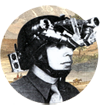Web 3.0
I'm crossposting my reaction to a SXSW Interactive panel from my personal blog. Enjoy!
Written March 14, 2009
I'm slightly frustrated right now. I just came from a session entitled Emerging Trends of Mobile Technology, where the launching pad started with smartphones. Throughout the session, the emphasis was on how we use old technology in combination with new ones to form an innovative tool. For example, image recognition to create augmented realities and find cut-throat product prices, &c.
Most people in the room seemed to be developers or designers of some sort, and many of the questions were based on cutting edge technology, the next wave, "web 3.0." But while everyone was drooling over their next money-generating app, a question was left out: What are the moral implications of this technology?
I'm not saying none of these things should be created, but with the rat-race to create the next best app, who's thinking about what we're potentially institutionalizing? Image recognition of the Coke brand that takes you directly to the site. Bar codes that show you product prices for the 10 closest competitors. Existing technology that might be creatively wielded via phones to discern race, sex, &c. through image recognition.
I mention these because they were the suggestions I took greatest issue with. I should give full disclosure at this point that I do not own a smart phone. The most cutting edge technology on my phone is T9. My impressions of how these phones (esp the iPhone) behave were primarily informed by the videos playing on screen.
Using specific examples, I'm going to illustrate what I mean, piece by piece.
- Brand recognition that leads you to a specific site: I don't expect this feature to stay the same (or at least hope not), but the video illustrated a smart phone snapping shots of a coke can. After processing the image, the phone landed the user on Coke's home page. The problem with this is probably apparent. It's a marketer's dream. But if phones are programmed to take users to specific product pages, what about commentary on those products? Those become secondary, and the user must take extra steps to find that content. An implication is made by this type of user landing. It makes it hard to find relevant commentary (i.e.: KillerCoke.org. At one point, Coke bought KillerCoke.com to intercept users).
- Barcodes and competition: I've seen the Google phone do this, where it will recognize a barcode and immediately pull up prices from nearby and online competitors. One person asked the panel about how this affects local businesses. The response was something along the lines of capitalism's goal is the end user's satisfaction. If businesses can't keep up with that, then they must come up with a more competitive strategy. Honestly, I disagree with this. Here are two thoughts.
- There is such a thing as a loss leader. One store's prices are sometimes cheaper than its competitor because other prices within the store make up for the loss.
- Some things have a cost that is not immediately clear. I posted a video of Ira Glass a couple of weeks ago in which he explained one of his convoluted stories. His point was that in order for us to eat better, Mexicans eat worse so we can get year-round tomatoes grown on their land. This parallels other issues as well: environmental effects, health hazards, &c.
- Profiling by leveraging existing technology: This was by far the most disturbing. The panelists mentioned there was existing technology already used by law enforcement to capture criminals by recognizing race, gender and many other features. What if this could be leveraged online to direct users to relevant suggestions and material? We are far from being beyond the constructions of race and gender. Why is it so important for demographic questionnaires to further subdivide"'white" into "white/non-Hispanic" or "Hispanic?" The classification has more to do with U.S. immigration than universal truth; every country defines race differently.
- In a recent example of institutionalizing race, SXSW offered a t-shirt with a white woman listening to her iPod. This was the only t-shirt they sold with any human figure on it, and instead of leaving the skin tone blank, they colored it in with a soft peach. "White" has become the new racelessness.
As far as gender and sex is concerned, which would image recognition be trying to identify? So many problems with gender and sex come from their dichotomies. Many contemporary human rights movements are trying to move beyond that. How might this technology reinforce what we're trying to leave behind?
I acknowledge that these were merely suggestions of a possible web 3.0 future and none of them might come true. However, what concerns me is the gravity of this brainstorm. At the very least, it is indicative of what's to come and should caution us about what could happen if profit and recognition spearhead innovation rather than improved service.














Comment from Jules Goins on March 23, 2009 - 1:14pm
This is a great article, Denise.
I come at the issue from the starting point of: where does the tech/programming stop and information distribution begins. From there, I can see where social/progressive info can flow (instead of/at the same time as) commercial info.
For instance, in the brand recognition example, I think one avenue to take would be to copy the front of the experience (scan a brand logo/image), but change the info given, from going to the company’s website to going to an adBuster or media literacy webpage detailing all the media, branding and corporate shenanigans for the company. This app would have to compete against the corporate app, but them’s the breaks.
For the barcode example, again, take the front end (scan barcode, find other retailers with the product) but attach it to explanations or socially/progressive associations. An example could be a Main Street backed page that shows where the same products are in locally owned stores, with each store having an explanation page on why their price might be higher and how they impact their community. Or, scan the barcode and find different products that are organic or locally grown or free trade in the same store or local stores.
For the profiling one, I am at a lost as to who would need an app that would figure out your race. To me, race is becoming a self-selection; why would you want a program to identify you instead of just picking that identification from the beginning?
This makes me think of the company that is building a Firefox-based browser for African Americans that will have pre-loaded sites of interest. Would you really want an app that would just load that up, or would you self-select that anyway? The most I could see is that the app would “recognize” that you are Black and suggest these types of items. I suppose this could be useful for first time users, but that would be it.
But what if instead of having the app round up this info and display choices, have the choices sent to you intelligently by “broadcasting” your interest? Why not have an avatar that tells others what you are interested in, and organizations or businesses that align with those interests “ping” you?
For example, you arrive in a city for business, but would like to eat during the travel at minority-owned business? You would set your avatar to “Looking for…Minority Owned Businesses”. A minority business organization would have a node or site that would broadcast out a map with their locations already pin’ed.
In all these instances, there must be a backbone organization and/or association that powers the app. One question that might arise is when does the tech innovation rest within the company that is producing the app? For example, should a nonprofit devoted to free trade products be able to piggyback development from a commercial or corporate-sponsored app that does similar things? Should the nonprofit have to build it from the ground up? Should there be an “open”, broken version offered to nonprofits? Could corporations give “in-kind” donations of the code to nonprofits?
Crap, this could be a blog post. I should totally get my own blog.
PS: Those t-shirt fools should know that the color of the multi-racial future is more a peanut-butter color than peach. Get your food/skin color combo right, people.
Comment from Denise Cheng on April 2, 2009 - 2:18pm
YAY!!!!!! Racialicious linked to my web 3.0 entry on my Wordpress blog!
Comment from Denise Cheng on April 2, 2009 - 2:38pm
You know what that totally made me think of when you brought up self-selection? I thought back to college when I took this ethnic politics class, and our professor related how a Ph.D candidate who was assigned to her was excited to encounter the Caucasian demographic option. Being from Europe, he was impressed by America's inclusiveness to the point where we would even have a box for those from the Caucas Mountains.